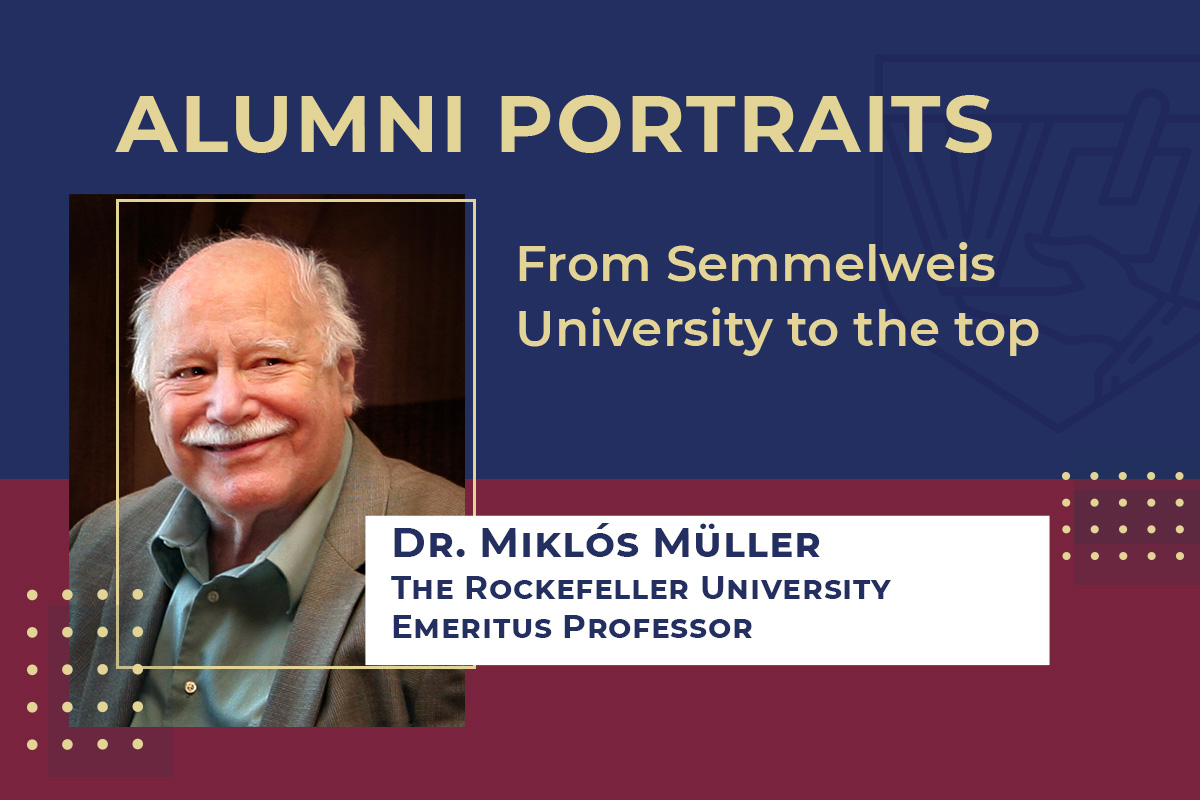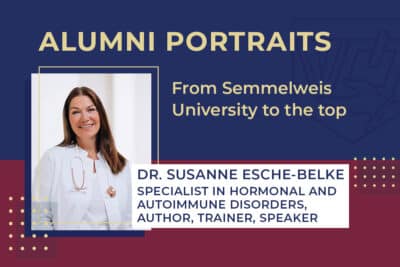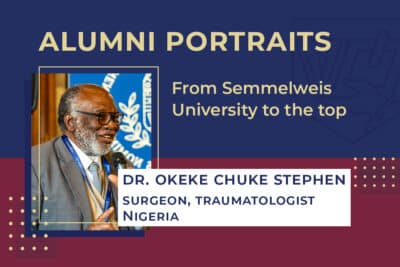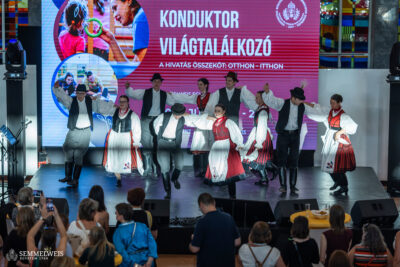What inspired you to choose medical studies, and Semmelweis University in particular?
I come from a family of intellectuals, and I have always been attracted to science, biology in particular. As a child I had an old microscope. I always wanted to be a scientist, above all a research biologist. But when I took my entrance exams, the Soviet, Michurinist version of biology prevailed, not only in the Soviet Union, but also in Hungary. I was admitted to both the biology and medicine degree programs at Eötvös Loránd University in Budapest (ELTE), but I didn’t know which one to choose. I thought that if I became a doctor, I would definitely have a future. But as a doctor, I could also have a future in the theoretical departments of medical universities and do biology. This is how I ended up becoming a research doctor.
Did you have a role model when you were young?
As a high school student, I already frequented the Department of Plant Physiology at ELTE, visiting Professor Nándor Gimesi. From him and his colleagues I learned cell biology and the use of modern microscopes. This gave me an early insight into life in an experimental biology laboratory, where I felt very much at home.
I could mention Kruif’s Microbe Hunters as a fascinating read, and even more so Sinclair Lewis’s Arrowsmith. Martin Arrowsmith was a country boy who went to the GP’s office regularly. He graduated from medical school and became a great professor of microbiology. He was fascinated by research and was accepted as a research fellow at the McGurk Institute in New York. The story is naive, but to me Martin was a role model. I daydreamed about one day working in a research institute like that. The writer had modeled the McGurk Institute on the Rockefeller Institute. It is almost unbelievable, but a few years later I started working there too.
Please tell us about your varied activities and how it all unfolded after graduation.
Now that’s like a fairy tale. After graduation, I was sent to the countryside, but based on my work in the student scientific circle, Professor Imre Törő arranged for me to be able to stay at the Department of Histology. I was also accepted as a doctoral student and so, in addition to my experimental work, I passed the doctoral exams in cell biology, biochemistry, and Marxism. Incidentally, in my philosophy doctoral dissertation I wrote boldly about how Lepeshinskaya’s new ‘Marxist cell biology’ could be considered absurd from the point of view of Marxist philosophy. Unfortunately, I do not have a copy of it. This was at a time when Törő had just been awarded the Hungarian state-sponsored Kossuth Prize for ‘proving’ Lepeshinskaya’s pseudo-scientific doctrine. I later wrote an article about this and the reception of Lepeshinskaya’s doctrine in Hungary in the journal Orvostörténeti Közlemények (Communicationes de Historia Artis Medicinae).
I had already conducted experiments as part of my work in the student scientific circle. Soon after graduating I started to publish my results, usually under the co-authorship of my colleagues at the institute. Having realized the exclusive role of Western journals by that time, I ‘cheekily’ sent one of my early short articles to the prestigious journal Nature, published in England, and it was accepted for publication! Subsequently, my work in Budapest led to a series of publications, some of which appeared in Acta Biologica of the Hungarian Academy of Sciences, and some again in international journals. The publications abroad played a decisive role in how my life continued to unfold.
The first volume of a series of handbooks launched by Academic Press (New York, London) and entitled Chemical Zoology, which discusses protozoa, was edited by G. W. Kidder, who asked me to write a chapter on unicellular digestion. Another such invitation was to attend a symposium in London in 1962, and participation in this had a decisive role in my career. The third invitation from abroad came in 1961 from the editorial board of the Journal of Protozoology, published in the USA, to become a member of the editorial board. I held this position for several years.
Years later, the Dutch publisher Elsevier asked me to launch a new international journal. Two colleagues and I organized and edited Molecular and Biochemical Parasitology for several years, which is now in its over 100th volume.
What gave you the exceptional opportunity to work at The Rockefeller University in New York? Can you tell us about your years there, and what it was like to work in the United States?
The story of how I became a colleague of Christian de Duve’s, who later won the Nobel Prize, is a long one. I was working on protozoa at Professor Törő’s institute, the main result of which was to show that the digestive vacuole of protozoa is closely related to mammalian lysosomes. We published a number of papers on this topic, some in scientific journals in the West. Lysosomes were discovered by de Duve and his colleagues. It was partly for their discovery that de Duve was awarded the Nobel Prize.
In 1963, the first international symposium specifically devoted to lysosomes was held in London for the small number of researchers working on the problem. I was invited to attend the rather private meeting on the basis of articles we had published in international journals. Here I had the opportunity to meet several leading cell researchers in person. On my return to Budapest, I wrote to some of them to say that I would like to continue my training and research in their laboratories under the ideal conditions prevailing there. Several of them offered me this opportunity. This is how I arrived in New York a year later. In de Duve’s department, I continued my cell biological and biochemical examinations of several protozoan species, in particular lysosomes and another organelle, peroxisomes, which had been discovered by de Duve in the meantime. The results of these studies showed that the organelles of many protozoans are closely related to the organelles typically found in multicellular organisms, thus supporting the theory that the structure and function of the cells of protozoans and multicellular organisms have much more in common than previously thought.
The other researcher who invited me to work with him, but could not hire me until a year later, was protein researcher Heinz Holter, a distinguished scientist at the Carlsberg Brewery laboratory. So, after my working in New York for a year, we returned to Europe, where I spent another year in Copenhagen studying the biochemistry of protozoans, while also really enjoying the city itself. After our year in Denmark, now with two children, we returned to the USA, where my ex-wife and I have lived ever since.
How did your years at Semmelweis University influence your later career?
Already as a second-year student, I was a member of a study group at the Second Department of Anatomy, when György Kiszely was still head of biology teaching there. Soon Professor Imre Törő arrived from Debrecen, who enabled me to start my own research on the nutrient uptake and intracellular digestion of protozoan organisms (ciliates, amoebae, etc.) already as a student. This work and the experience I gained from it formed the basis for my further achievements.
What do you consider your greatest success in your career so far?
I consider it a success that my initial achievements led me to a well-known institution where many excellent researchers have worked, and one that has boasted and still boasts a large number of Nobel Prize winners. That is where I studied biochemistry, partly through our experiments. Our work was published in leading journals, and my bibliography contains over 200 articles and book chapters. An article of ours offering a summary of the larger topic, published in 2012, is cited in 659 works.
I am proud to have been awarded an honorary doctorate by Paris Descartes University and to be an honorary member of several scientific societies at home and abroad. At home, I was elected an honorary member of the Hungarian Society of Parasitologists and the Hungarian Society for Microbiology. I am an external member of the Hungarian Academy of Sciences and have been awarded the Order of Merit of the Republic of Hungary for my scientific work and my patronage of the arts. As an important part of my non-scientific work, I translated Ervin Bauer’s Theoretical Biology into Hungarian and later wrote a book about his life and work; in addition, I have been studying the history of science.
What advice can you give to our undergraduate medical students?
I found excellent and active mentors already when I was in high school, and later when I went abroad, I was also supported by such people. I quickly recognized the importance of having an international presence. An active knowledge of several languages is very important. In addition to Hungarian, I already spoke good German and English in high school and soon learned Russian, as well as enough French to be able to use French scientific literature easily. I think all these factors could be important for today’s students too on their road to success.
Alumni Directorate
Translation: Dr. Balázs Csizmadia



